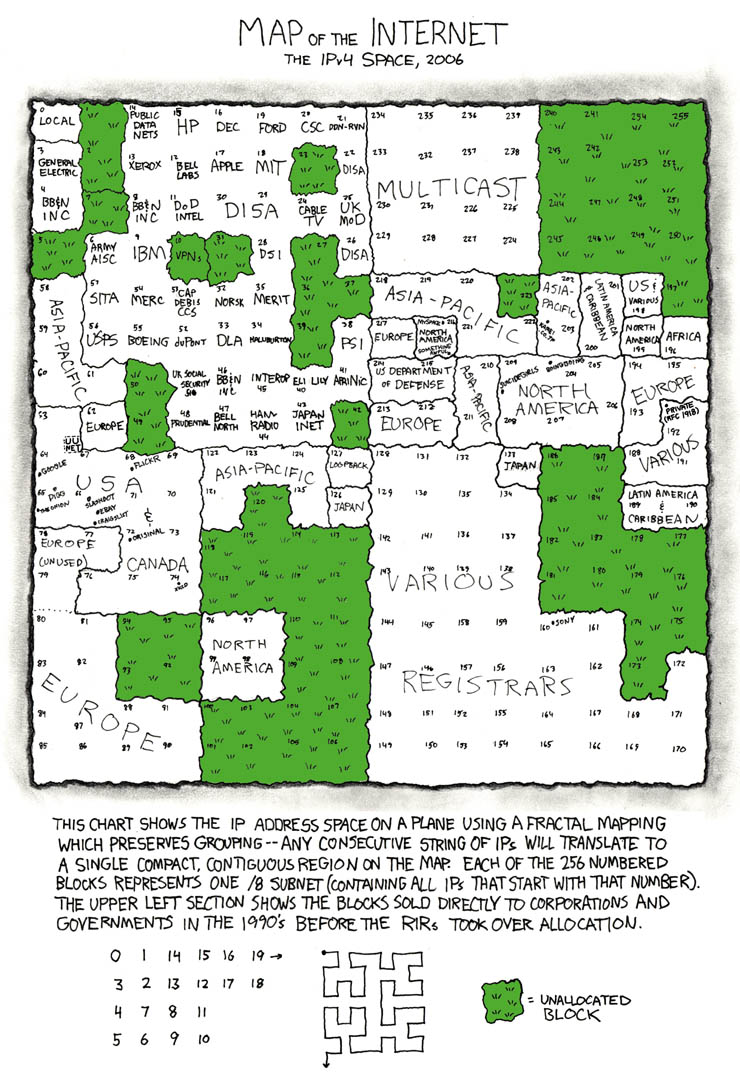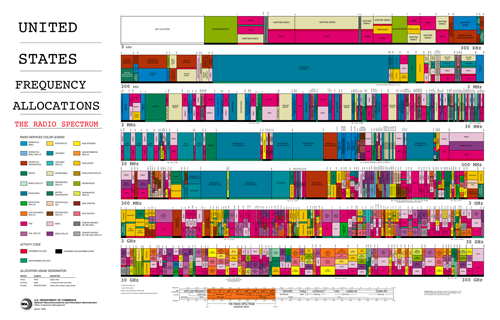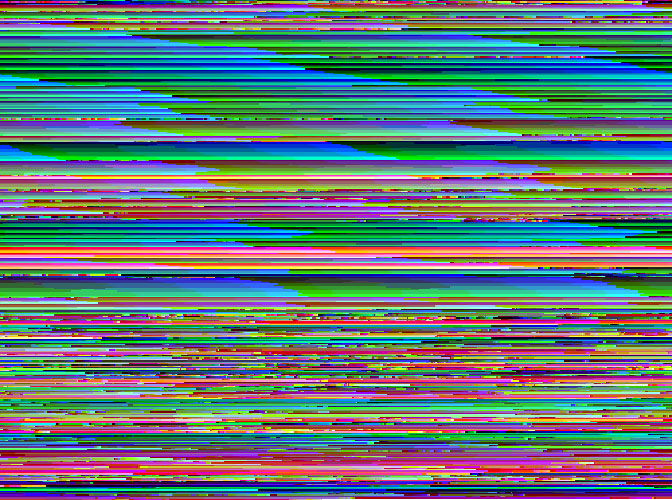You are here: Foswiki>Dmi Web>GovcomorgJubilee>AlternativeAlgorithms (28 Sep 2009, ErikBorra)Edit Attach
Alternative Algorithms
Team
Alexander Galloway, Rosa Menkman, Michael Stevenson, Laura van der Vlies, Erik Borra. Design by Marieke van DijkDescription
In this project we wish to explore number spaces, specifically the numerical range of available IP addresses. Google has given us the ranked list of search engine returns. Librarians and editors provide directories, the Web categorized helpfully into topics. There is a third way of navigating the Web, still present in the next blog feature of blogspot.com, which recalls early Web rings. The IP Browser creates an alternative browsing experience that foregrounds the Webs machine habitat and returns the user back to the basics of orderly Web browsing. The IP Browser looks up your IP address, and allows you to browse the Websites in your IP neighborhood, one by one in the order in which they are given in the IP address space. The IP browser has a limited set of features: the user can either click to the next higher IP address or next lower one, using forward and backward buttons. Like a radio scanner, the browser skips over empty parts of the spectrum, incrementing the current IP address upward or downward until the next IP hosting a web service on port 80 is found. In this way, the user is able to browse specific IP address neighborhoods. The IP Browser re‐contextualizes the Web as infrastructure within which websites are fit.Question
How to create an alternative browsing experience that foregrounds the Web's machine habitat.Sketches
|
Single channel "TV" interface |
Neighborhood with left/right movement |
Neighborhood comparisons with three bands |
IP address space
Iana IPv4 Global Unicast Address Assignments. Wikiscanner List anonymous wikipedia edits from interesting organizations. Find IP Address Find IP addresses per country.Related Maps and Projects
| Visualizing the IPv4 Number Space | |
|---|---|
Source: http://xkcd.com/195/ |
Source: http://icicle.dylex.net/~ipmap/ |
| U.S. Frequency Allocation | 1:1 is an art project by Lisa Jevbratt. The project looked to create "a database that would contain the addresses of all the websites in the world and interface through which to view and use the database." Visualizations from 1:1 are 'zoomed out,' giving a sense of the size and complexity of the number space. |
 |
 |
Quotations
Galloway, Notes for a Liberated Computer Language, http://r-s-g.org/LCL/ Manovich, Language, p252: "New Media spaces are always spaces of navigation." Chun, Freedom and Control, p44: "Ips simultaneously impose, obfuscate, and displace location, address, area and coordination. The internet, through its URLs, disengages name from location and location from geography while offering the virtue of location." Chun, Freedom and Control, p46: "New Media spaces [...] are fundamentally unnavigable. Users may navigate and control software interfaces, but this control compensates for, if not screens, the lack of control they have over their data's path. Users do not navigate their packets." Rogers, Politics of Web space, p7:"Crucially, with or without maps, these associations formed by hyperlinks came to be known as ‘spaces,’ e.g., the ‘hate space’ on the Web (Sunstein, 2001). In other words, selective link-making creates space when one conceives of space as that demarcated and shaped by limited acts of association. The demarcationist, space-making approach had another important consequence. It performed an important break with cyberspace by suggesting that hyperlinking behaviors dismantle the 'open-ended-ness' of cyberspace, an idea that informed 'placeless-ness' and led to what one may call ‘place-less space’. " The Economist, The Revenge of Geography: "Your nearest web page"Method
Our project concerns the same IPv4 space, but zooms in to allow users to navigate by IP. Moving from one address to another, users are confronted with a Web normally out of sight.Outcomes
1. IP Browser, http://ipbrowser.digitalmethods.net 2. IP Browser of the Palestinian IP Range, http://tools.issuecrawler.net/beta/ip_diagnostics/Follow up projects
- Question: In the available IP address number space, what percentage of IP addresses contain computers running a Web server? Of these resulting web pages, what percentage of the pages are meant for public use?
- 1:1 but then on port 80 and with screenshots of the landing page. Then 1px per screenshot with possibility to zoom with factors 10.
- add vertical scroll by ip2domain service
- add ranges (e.g. countries, isps, companies) for pre-selection
- cache ranges to enable quick overview of that range
- map ip2geo in google earth (see also http://geourl.org/), provide list of ips per lat/lon, provide list of domains per ip
- add data like lat/lng, whois, language, ...
FAQ
- Sometimes the IP Browser breaks out of it's interface. This is because some sites do not allow embedding in iframes. Please click the back button and avoid the particular IP.
- Sometimes there is a pop-up asking me for credentials. This is because some sites require authentication. Just click 'cancel'.
| I | Attachment | Action | Size | Date | Who | Comment |
|---|---|---|---|---|---|---|
| |
1-1_jevratt.jpg | manage | 187 K | 14 Aug 2008 - 09:34 | MichaelStevenson | 1:1 Lisa Jevbratt |
| |
IMG_0703.JPG | manage | 33 K | 13 Aug 2008 - 13:59 | Main.alex | |
| |
IMG_0704.JPG | manage | 29 K | 13 Aug 2008 - 14:00 | Main.alex | |
| |
IMG_0705.JPG | manage | 30 K | 13 Aug 2008 - 14:00 | Main.alex | |
| |
map.png | manage | 149 K | 13 Aug 2008 - 13:22 | Main.alex | IPv4 number space map |
| |
map_of_the_internet.jpg | manage | 204 K | 13 Aug 2008 - 13:19 | Main.alex | Map of the Internet (IPv4 number space) |
| |
us_spectrum_map.png | manage | 134 K | 14 Aug 2008 - 09:17 | MichaelStevenson |
Edit | Attach | Print version | History: r19 < r18 < r17 < r16 | Backlinks | View wiki text | Edit wiki text | More topic actions
Topic revision: r18 - 28 Sep 2009, ErikBorra
 Copyright © by the contributing authors. All material on this collaboration platform is the property of the contributing authors.
Copyright © by the contributing authors. All material on this collaboration platform is the property of the contributing authors. Ideas, requests, problems regarding Foswiki? Send feedback


